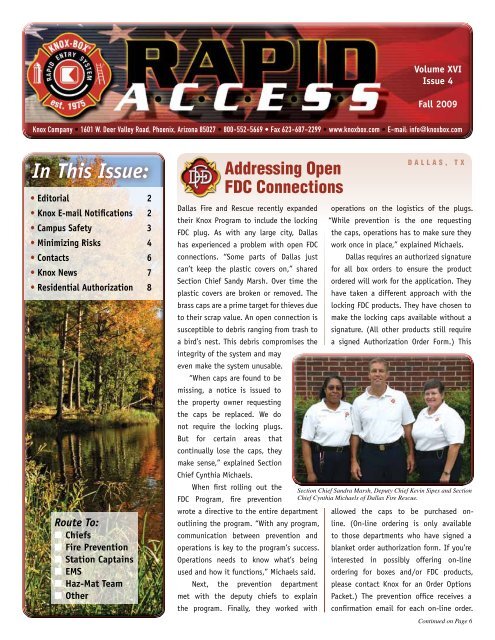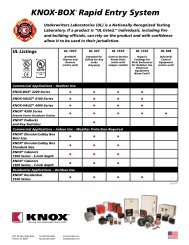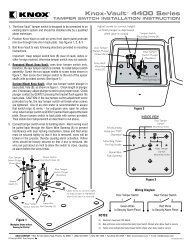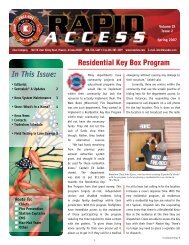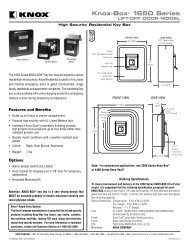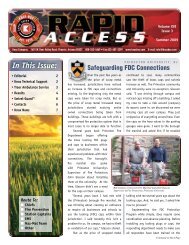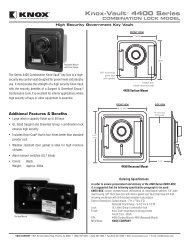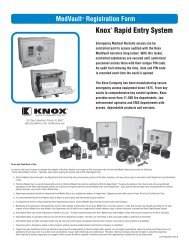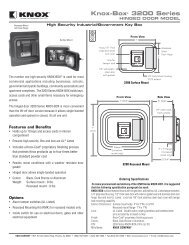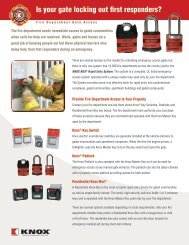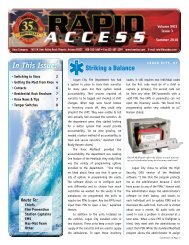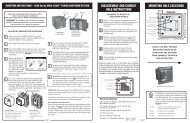In This Issue: - Knox Box
In This Issue: - Knox Box
In This Issue: - Knox Box
You also want an ePaper? Increase the reach of your titles
YUMPU automatically turns print PDFs into web optimized ePapers that Google loves.
Volume XVI<br />
<strong>Issue</strong> 4<br />
Fall 2009<br />
<strong>Knox</strong> Company • 1601 W. Deer Valley Road, Phoenix, Arizona 85027 • 800-552-5669 • Fax 623-687-2299 • www.knoxbox.com • E-mail: info@knoxbox.com<br />
<strong>In</strong> <strong>This</strong> <strong>Issue</strong>:<br />
• Editorial 2<br />
• <strong>Knox</strong> E-mail Notifications 2<br />
• Campus Safety 3<br />
• Minimizing Risks 4<br />
• Contacts 6<br />
• <strong>Knox</strong> News 7<br />
• Residential Authorization 8<br />
Route To:<br />
■ Chiefs<br />
■ Fire Prevention<br />
■ Station Captains<br />
■ EMS<br />
■ Haz-Mat Team<br />
■ Other<br />
Addressing Open<br />
FDC Connections<br />
Dallas Fire and Rescue recently expanded<br />
their <strong>Knox</strong> Program to include the locking<br />
FDC plug. As with any large city, Dallas<br />
has experienced a problem with open FDC<br />
D A L L A S , T X<br />
operations on the logistics of the plugs.<br />
“While prevention is the one requesting<br />
the caps, operations has to make sure they<br />
work once in place,” explained Michaels.<br />
connections. “Some parts of Dallas just<br />
can’t keep the plastic covers on,” shared<br />
Section Chief Sandy Marsh. Over time the<br />
plastic covers are broken or removed. The<br />
brass caps are a prime target for thieves due<br />
to their scrap value. An open connection is<br />
susceptible to debris ranging from trash to<br />
a bird’s nest. <strong>This</strong> debris compromises the<br />
Dallas requires an authorized signature<br />
for all box orders to ensure the product<br />
ordered will work for the application. They<br />
have taken a different approach with the<br />
locking FDC products. They have chosen to<br />
make the locking caps available without a<br />
signature. (All other products still require<br />
a signed Authorization Order Form.) <strong>This</strong><br />
integrity of the system and may<br />
even make the system unusable.<br />
“When caps are found to be<br />
missing, a notice is issued to<br />
the property owner requesting<br />
the caps be replaced. We do<br />
not require the locking plugs.<br />
But for certain areas that<br />
continually lose the caps, they<br />
make sense,” explained Section<br />
Chief Cynthia Michaels.<br />
When first rolling out the<br />
FDC Program, fire prevention<br />
Section Chief Sandra Marsh, Deputy Chief Kevin Sipes and Section<br />
Chief Cynthia Michaels of Dallas Fire Rescue.<br />
wrote a directive to the entire department<br />
outlining the program. “With any program,<br />
communication between prevention and<br />
operations is key to the program’s success.<br />
Operations needs to know what’s being<br />
used and how it functions,” Michaels said.<br />
allowed the caps to be purchased online.<br />
(On-line ordering is only available<br />
to those departments who have signed a<br />
blanket order authorization form. If you’re<br />
interested in possibly offering on-line<br />
ordering for boxes and/or FDC products,<br />
Next, the prevention department please contact <strong>Knox</strong> for an Order Options<br />
met with the deputy chiefs to explain<br />
the program. Finally, they worked with<br />
Packet.) The prevention office receives a<br />
confirmation email for each on-line order.<br />
Continued on Page 6
E d i t o r i a l<br />
We’d like to say thank you to those<br />
who took the time to complete the<br />
survey we sent earlier this year to all<br />
<strong>Knox</strong> Coordinators via email. Overall,<br />
the response to the survey has been<br />
outstanding. Your positive comments<br />
and report has been very encouraging<br />
to our staff. For those who did have a<br />
concern or suggestion, we are reviewing<br />
your comments and are working to<br />
address them. Again, thank you for<br />
taking the time to complete the survey.<br />
Your feedback is very important to us.<br />
If you haven’t checked out what is new<br />
at <strong>Knox</strong>, I’d suggest you stop by our<br />
booth at an upcoming tradeshow in<br />
your area. Since many of you may not<br />
be able to travel to the national shows<br />
due to the economic downturn, we have<br />
made a company decision to continue<br />
to exhibit at many of the state and<br />
regional shows. So even if you can’t<br />
travel to one of the national shows, you<br />
should still be able to see <strong>Knox</strong> at a<br />
local show. On page 7, you will find a<br />
short listing of some of the upcoming<br />
shows where we will be exhibiting.<br />
Thank you for your support of the <strong>Knox</strong><br />
System. We look forward to serving<br />
your department for years to come.<br />
<strong>Knox</strong> E-Mail Notifications<br />
The <strong>Knox</strong> Company is dedicated to providing Fire Departments with the most<br />
accurate and current information available. With this in mind, <strong>Knox</strong> can now send<br />
e-mail notifications to departments for certain events: shipment confirmations for<br />
products purchased for use within their jurisdiction and electronic updates for both<br />
KeySecure ® and Sentralok ® units as soon as they become available.<br />
Shipment Confirmations<br />
• <strong>In</strong>clude: Package Tracking <strong>In</strong>formation<br />
<strong>In</strong>stallation Address<br />
Item(s) Shipped<br />
Name and address of Purchaser<br />
• Sent to the <strong>Knox</strong> Coordinator only<br />
• Purchaser of product will receive a<br />
shipment confirmation if an e-mail<br />
address is provided on the <strong>Knox</strong><br />
Authorization Order Form<br />
• Generated daily<br />
Electronic Updates<br />
• Provides information on software<br />
updates or product enhancements<br />
and implementation instructions<br />
• Sent to the <strong>Knox</strong> Coordinator<br />
• Additional individuals can be<br />
designated to receive electronic<br />
updates<br />
• Generated as updates<br />
become available<br />
To sign your department up to receive these e-mail notifications, please contact<br />
<strong>Knox</strong> Fire Support at 800-566-9269. Since these e-mail notifications are<br />
auto-generated, they can not be re-generated once sent. Once your department<br />
is set-up for e-mail notification, please add the ‘knoxbox.com’ domain to your<br />
‘trusted senders’ list, to ensure e-mails are not sent to your junk folder or blocked<br />
by spam filters.<br />
Editor<br />
Cynthia Jones<br />
Publisher<br />
<strong>Knox</strong> Company<br />
Art Director<br />
Cynthia Weiss<br />
All products mentioned in this document are registered<br />
trademarks and copyrighted by their respective<br />
owners.<br />
Rapid Access is published bimonthly by <strong>Knox</strong><br />
Company, 1601 W. Deer Valley Road, Phoenix, AZ<br />
85027. ©2009 <strong>Knox</strong> Company. All Rights Reserved.<br />
2
Working to Improve Campus Safety<br />
U N I V E R S I T Y O F I O W A<br />
Several years back, The<br />
University of Iowa’s Fire<br />
Prevention Department<br />
began working with the<br />
Iowa City Fire Department to implement<br />
the <strong>Knox</strong> Program within their campus.<br />
While Iowa City had been using the <strong>Knox</strong><br />
System for years, the program had never<br />
been implemented at the university. “When<br />
you put the numbers to paper, if the fire<br />
department has to force a $500 door to<br />
investigate why an alarm is going off in a<br />
specific area, you have essentially paid for<br />
two <strong>Knox</strong>-<strong>Box</strong>es. The facility department<br />
likes the concept of paying a little to<br />
put in a <strong>Knox</strong>-<strong>Box</strong> than to pay for a new<br />
door that didn’t need to be destroyed,”<br />
shared Bruce McAvoy, Fire Safety<br />
Coordinator for the University of Iowa.<br />
The university has traditionally relied<br />
on the public safety officers on campus<br />
to let the fire department into buildings.<br />
The public safety department keeps rings<br />
of keys to campus buildings in their office.<br />
When an alarm sounds, a public safety<br />
officer grabs the key rings and runs to<br />
the building to meet the fire department.<br />
“While they’ve done an excellent job<br />
doing this over the years, we think they<br />
can improve the process by installing<br />
a <strong>Knox</strong>-<strong>Box</strong> with specific keys inside,”<br />
stated Bruce McAvoy. If the building has a<br />
<strong>Knox</strong>-<strong>Box</strong>, there is no need to grab the key<br />
rings. Eventually all buildings on campus<br />
will have a box eliminating the need for<br />
the key rings. “<strong>This</strong> will improve safety on<br />
campus,” said McAvoy.<br />
<strong>In</strong> addition to the boxes, the university<br />
is also installing FDC locking plugs on all<br />
new construction. The plugs are mandated<br />
for new construction and any building that<br />
is being renovated. “The city started using<br />
them (locking plugs) and we followed<br />
suit. While we haven’t experienced a lot of<br />
theft, the plugs improve the survivability<br />
of our brass products. You figure a couple<br />
hundred dollars into the initial cost of the<br />
building, it’s a small drop in the bucket,”<br />
explained McAvoy.<br />
<strong>In</strong> June 2008, the main campus<br />
experienced a 500 year flood of the Iowa<br />
River. (A flood described as having a<br />
chance of occurring once every 500 years<br />
or 0.2% chance in any given year.) Many<br />
buildings on campus became submerged<br />
and experienced extensive damage. “We<br />
installed boxes and plugs on all the<br />
buildings that were flooded last year.<br />
While most of the buildings are now<br />
occupied some are still vacant. Even if<br />
the building is vacant, the alarm and<br />
fire protection systems are still operable.<br />
Bruce McAvoy installing <strong>Knox</strong> ® Locking FDC plugs<br />
at Kinnick Stadium<br />
(Fire protection systems were put back<br />
into service between the response and<br />
stabilization phases.) Additionally, the<br />
fire protection contractors were required<br />
to flush the FDCs on the flooded buildings<br />
to make sure debris didn’t get into the<br />
system. Once a system is flushed, locking<br />
plugs are being installed.<br />
The surface mounted 3200 hinged<br />
box is the standard product installed on<br />
campus. A hinged box allows for single<br />
hand operation and the lid cannot be<br />
misplaced. Additionally, all boxes on<br />
campus are sub-mastered. <strong>This</strong> allows the<br />
campus’ public safety officers to open the<br />
boxes in addition to the fire department.<br />
The public safety officer’s keys only work<br />
on the sub-mastered product located on<br />
campus. They do not work on the boxes<br />
located within Iowa City since those boxes<br />
are not sub-mastered.<br />
Currently only about half of all the<br />
buildings on campus with monitored fire<br />
alarms have a <strong>Knox</strong>-<strong>Box</strong> key box. The<br />
university has been adding boxes and plugs<br />
as buildings are built and older buildings<br />
are renovated or a fire protection system<br />
is installed or updated. As a result of the<br />
flooding, many buildings on campus have<br />
recently been renovated.<br />
Finding funds for the boxes can be an<br />
issue for schools since they must purchase<br />
their own boxes. “I’m working on a fire<br />
protection grant application for the next<br />
grant period – needs assessment, risk<br />
report, etc. <strong>In</strong> the mean time, our facility<br />
manager is able to fund some of the boxes<br />
out of their budget. Our department has a<br />
good working relationship with the facility<br />
management department. If they have<br />
funds left at the end of the fiscal year,<br />
they use some of the left over money to<br />
purchase boxes. It’s cheaper than having<br />
the replace a door that’s been forced<br />
open,” shared McAvoy.<br />
The University of Iowa, in Iowa<br />
City, has more than 30,000 students. Its<br />
campus has more than 120 buildings of<br />
which 112 have monitored fire protection<br />
systems. Fire protection for the main<br />
campus in Iowa City is provided by the<br />
Iowa City Fire Department. The university<br />
has its own Department of Public Safety<br />
which is charged with oversight of fire<br />
safety within the campus.<br />
3
Minimizing Risks<br />
Uncertainty. Not a word that describes how most people<br />
want to live their lives. <strong>This</strong> is especially true when it involves<br />
our professions and lifestyle. It is however, exactly how<br />
virtually everyone goes about their day to day activities. <strong>In</strong><br />
simple terms, we live our lives with the uncertainty of the<br />
outcome of most of the choices we make each day. Will that<br />
car stop Is the gauge on this air pack accurate Will this rope<br />
hold me and a victim All individuals, especially those in public<br />
safety take on these challenges every day of the year. Every<br />
time the tone goes off and the crew pulls out of the station,<br />
they are assuming the risks. Every time an officer walks up<br />
to talk to the driver of a car they have just stopped, they are<br />
taking a huge risk. Professional Risk and Emergency Managers<br />
deal with these issues every day. They deal with them on a<br />
global level. Natural disasters are on the rise. <strong>In</strong>stances of civil<br />
unrest and terrorism are also increasing in frequency. It seems<br />
like the FBI is breaking up a plot every few days. Terms like<br />
Threat Evaluation, Consequence Management, and Continuity<br />
of Government are becoming part of the language of the Fire<br />
Service. The real measure of how effective any public safety<br />
organization functions will be measured by how they recognize<br />
and prepare for current threats and their ability to react to<br />
emerging needs.<br />
Risk in the 21st Century<br />
Risk management utilizes the notion that if we use a<br />
consistent logical approach to identifying potential threats<br />
and employ a disciplined approach to mitigating the threat,<br />
we can face life’s uncertainties with some level of peace<br />
and security. For the government, it is essential that every<br />
reasonable step be taken to protect the lives and property of<br />
the citizens they are sworn to serve. One of the leaders in the<br />
current trends of modern risk management is Peter Bernstein.<br />
<strong>In</strong> his book Against the Gods: The<br />
Remarkable Story of Risk, Bernstein states<br />
that for most of American history we<br />
have relied on the concepts of “Faith and<br />
Luck” as the cornerstones of our efforts<br />
to manage risk. As Bernstein puts it,<br />
“If everything is a matter of luck, risk<br />
management is a meaningless exercise.”<br />
It is clear today that we must all take<br />
a hard look at risk and vulnerability in<br />
our community. We should assess our<br />
strengths and weakness and look for tools<br />
that can help us protect our community<br />
and resources.<br />
Federal mandate<br />
Identifying risk and formulating an<br />
action plan based on those risks is so<br />
valuable that it is one of the cornerstones<br />
of FEMA’s Aid to Fire Grant program. The<br />
FEMA Program Guidance for the 2009<br />
FP&S states: “The assessment of fire risk is<br />
essential in the development of an effective<br />
project goal, as well as meeting FEMA’s goal<br />
of the conduct of risk analysis as a basis for<br />
action.” <strong>This</strong> is so fundamental to FEMA<br />
that the Vulnerability Assessment coupled<br />
with the Implementation Plan constitutes<br />
40% of the evaluation/scoring criteria<br />
used by of the Technical Evaluation<br />
Panels (TEP). Failure to articulate these<br />
requirements can eliminate a project from<br />
consideration.<br />
Steps to Risk Assessment/<br />
Hazard Mitigation<br />
Risk assessment is the process of<br />
analyzing threats and vulnerabilities,<br />
the potential impact, and identifying<br />
resources and capabilities. The resulting<br />
findings are used as a basis for identifying<br />
appropriate mitigation techniques,<br />
upgrading equipment and instituting<br />
training and procedures to meet the<br />
contingency. Here are some practical steps<br />
to conducting a risk assessment.<br />
4
y Larry Pigg<br />
1. Identify the hazards.<br />
<strong>This</strong> will include an analysis of<br />
potential scenarios and threats. Is there<br />
an identified Haz-Mat route through your<br />
jurisdiction Do you have a major sporting<br />
complex After you identify the potential<br />
risks, focus on the likely threats. Once you<br />
have identified the potential hazards, and<br />
the likely events, you can develop a threat<br />
matrix that focuses on your vulnerabilities<br />
and resources you can rely on to meet<br />
the threat.<br />
2. Determine who is at Risk.<br />
Do you have retirement communities,<br />
state institutions, hospitals or any other<br />
special population groups that would<br />
be uniquely vulnerable Do you have<br />
a community evacuation plan in case<br />
of a Haz-Mat or weather related event<br />
Before you can make any decisions on<br />
how to respond, you must first be able<br />
to identify what groups are at a particular<br />
disadvantage should a catastrophic<br />
event occur.<br />
3. Evaluate the Risks.<br />
Now it’s time to take your data and<br />
correlate the vulnerabilities and the<br />
available assets. Risks are calculated by<br />
taking the events that pose the greatest<br />
danger and overlaying them on the<br />
expected or potential frequency. Experts<br />
suggest that the intent is not to cover<br />
every vulnerability, only those that pose<br />
the greatest risk to the community.<br />
“Vulnerability management is a matter of<br />
risk assessment as well as the ability to<br />
take a slice across an entire organization,”<br />
advises Mitchell Ashley, chief technology<br />
officer of StillSecure, a network security<br />
company.<br />
4. Develop an Action Plan.<br />
Review your current plans and modify<br />
them as needed. Once your vulnerabilities<br />
and assets have been identified, and the<br />
risks assessed, you have to decide what<br />
action you can take. What can be done<br />
to mitigate or completely block the<br />
risks Is the leadership team, including<br />
elected officials prepared to function at a<br />
high level under extreme circumstances<br />
Do you have multiple layers of trained<br />
personnel that can function for long<br />
periods of time Do you need additional<br />
training Can the most vulnerable systems<br />
be fixed immediately, or do you need<br />
modifications to both the infrastructure<br />
and the organization<br />
Solutions<br />
Once you have done your assessment<br />
and made the appropriate modifications<br />
to the system, document your findings<br />
and set up a program to regularly test<br />
the system and evaluate your progress.<br />
Once your system is completely ready,<br />
your people trained and your plans fully<br />
implemented, it is time to start the<br />
process over again. The following are <strong>Knox</strong><br />
solutions to common community risks:<br />
• Promote fire prevention and enforce<br />
the fire code. All of the model fire<br />
codes have provisions that allow the<br />
fire department to require emergency<br />
access.<br />
• Protect vulnerable FDC connections<br />
with <strong>Knox</strong> locking caps/ plugs. Fire<br />
sprinklers protect property and do save<br />
lives, sometimes those of firefighters.<br />
• Pass a local ordinance to require that all<br />
target structures have a key box in close<br />
proximity. Do the same for emergency<br />
elevator operation and power perimeter<br />
access gates.<br />
• Apply for a grant. The AFG program is<br />
proving to be a valuable tool. When<br />
used to support a local ordinance these<br />
grants can have a long-term positive<br />
impact on your community.<br />
• <strong>In</strong>stall a secure cabinet to store critical<br />
incident information or tactical plans.<br />
These could include Haz-Mat facilities,<br />
staging areas, schools or any other<br />
target occupancy that offer unique<br />
challenges and risks for emergency<br />
responders.<br />
Conclusion<br />
Proactive risk management is a vital<br />
part of the delivery of service for fire and<br />
police departments in the twenty-first<br />
century. Minimizing these risks will take<br />
on many forms. It will take a total effort<br />
of all of your available resources to meet<br />
the challenges. One of the lessons that<br />
we have learned over the past few years<br />
is that no fire department in America, no<br />
matter how big, can manage all the aspects<br />
of a major catastrophe by themselves.<br />
Use unconventional methods to meet<br />
emerging threats. Utilize volunteer groups<br />
like Citizen Corps and other community<br />
based citizen groups. Strengthen and<br />
update your mutual aid agreements. Look<br />
for areas of vulnerability and implement<br />
programs or legislative changes to meet<br />
current needs. The days of relying on the<br />
concepts of “faith and luck” alone are over.<br />
<strong>In</strong>dividuals and communities must analyze<br />
their surroundings, identify potential<br />
threats, and take positive proactive steps<br />
to lessen the damaging impact.<br />
5
AK<br />
YT<br />
<strong>Knox</strong> Contacts<br />
NT<br />
NU<br />
Open FDC<br />
connections<br />
Continued from Front Page<br />
D A L L A S , T X<br />
HI<br />
CA<br />
OR<br />
WA<br />
BC<br />
NV<br />
Northwest<br />
Jeff<br />
Moser<br />
866-361-5844<br />
Fax 866-361-5845<br />
jmoser@knoxbox.com<br />
West<br />
Marlene<br />
Briones<br />
866-702-4406<br />
Fax 866-275-4039<br />
mbriones@knoxbox.com<br />
Southwest<br />
Rebecca<br />
Heller<br />
866-417-8458<br />
Fax 800-704-0889<br />
rheller@knoxbox.com<br />
FIRE DEPARTMENT<br />
SUPPORT<br />
<strong>This</strong> department provides<br />
customer service to fire<br />
departments.<br />
800-KNOX-BOX<br />
(800-566-9269)<br />
ID<br />
AZ<br />
UT<br />
AB<br />
MT<br />
WY<br />
NM<br />
CO<br />
SK<br />
ND<br />
SD<br />
NE<br />
TX<br />
KS<br />
OK<br />
MB<br />
MN<br />
IA<br />
MO<br />
AR<br />
LA<br />
Central<br />
Joe<br />
Shanley<br />
866-223-2623<br />
Fax 866-223-2640<br />
jshanley@knoxbox.com<br />
North Central<br />
Larry<br />
Lulich<br />
866-889-4181<br />
Fax 866-613-9412<br />
llulich@knoxbox.com<br />
South<br />
Virginia<br />
Cardwell<br />
866-504-7230<br />
Fax 866-562-0657<br />
vcardwell@knoxbox.com<br />
ON<br />
ELECTRONIC<br />
SUPPORT<br />
<strong>This</strong> department deals<br />
exclusively with technical<br />
questions regarding KeySecure®,<br />
Sentralok® and MedVault® units.<br />
866-KNOX-BOX<br />
(866-566-9269)<br />
WI<br />
FIRE SERVICE MANAGERS<br />
SUPPORT CONTACTS<br />
IL<br />
IN<br />
TN<br />
MI<br />
KY<br />
OH<br />
MS AL GA<br />
WV<br />
SC<br />
FL<br />
PA<br />
QC<br />
VA<br />
NC<br />
NY<br />
MD<br />
VT<br />
NJ<br />
DE<br />
DC<br />
NL<br />
ME<br />
CT RI<br />
CARIBBEAN<br />
Northeast<br />
Jon<br />
Kemp<br />
866-436-0493<br />
Fax 866-436-0494<br />
jkemp@knoxbox.com<br />
NB<br />
NH<br />
MA<br />
Atlantic<br />
Bryan<br />
Mc<strong>In</strong>tosh<br />
877-707-5286<br />
Fax 877-773-4197<br />
bmcintosh@knoxbox.com<br />
Southeast<br />
Bill<br />
Brown<br />
888-342-3530<br />
Fax 888-342-6655<br />
bbrown@knoxbox.com<br />
PROPERTY OWNER<br />
SUPPORT<br />
Property Owners & General<br />
<strong>In</strong>quiries to <strong>Knox</strong> should be<br />
directed to our main number.<br />
800-552-KNOX<br />
(800-552-5669)<br />
PE<br />
NS<br />
<strong>This</strong> allows them to know which buildings<br />
have ordered the FDC plugs. To help<br />
facilitate property owners in ordering the<br />
plugs, Dallas has a customized handout<br />
with the on-line ordering instructions.<br />
Additionally, the fire department<br />
has chosen to have sprinkler contractors<br />
install the plugs rather than the fire<br />
marshal’s office. <strong>This</strong> reduces the time<br />
requirements of the fire marshals office<br />
in installing and maintaining the FDC<br />
Program. (<strong>Knox</strong> requires a completed<br />
contractor registration form for each<br />
sprinkler contracting company to receive<br />
a <strong>Knox</strong> Keywrench.)<br />
As with any new program, there were<br />
a few concerns when the locking plugs<br />
were first introduced into the department.<br />
One concern dealt with corrosion of the<br />
metal connection and plug. Would it be<br />
difficult to get the plug off after it had<br />
been on the connection for a while<br />
<strong>Knox</strong> actually considered this issue when<br />
designing the plug and selected the<br />
material of the locking plug so that this<br />
wouldn’t be an issue. The locking plug is<br />
made of stainless steel making it highly<br />
resistant to galvanic corrosion.<br />
Dallas Fire and Rescue is a full<br />
service department providing service to a<br />
population of 1.3 million.<br />
<strong>Knox</strong> ® FDC Plug<br />
with Swivel-Guard <br />
6
Congratulations<br />
to our Fire Rescue<br />
<strong>In</strong>ternational<br />
Weathervane Winner!<br />
Division Chief<br />
Dennis Vickers<br />
Tallahassee Fire Department<br />
KNOX NEWS<br />
2009 Tradeshow Schedule<br />
Show Location Dates<br />
EMS Expo Atlanta, GA Oct 28-30<br />
FL Fire Prevention Conference Maitland, FL Nov 2-5<br />
Wisconsin Fire <strong>In</strong>spectors Wausau, WI Nov 3-7<br />
Association of Fire Districts NY Ellenville, NY Nov 5-7<br />
CO EMS Keystone, CO Nov 6-7<br />
Caribbean Fire Chiefs Montego Bay, Jamaica Nov 16-18<br />
Illinois Fire <strong>In</strong>spectors Addison, IL Nov 18-19<br />
FREE<br />
Literature<br />
As a reminder, colorful brochures<br />
explaining the benefits of the<br />
<strong>Knox</strong> Rapid Entry System are<br />
available to your department for<br />
distribution to property owners.<br />
<strong>This</strong> literature is available at no<br />
charge to all departments. Contact<br />
Fire Department Support or log<br />
on to www.knoxbox.com and click<br />
on support/request literature.<br />
Hawaii Fire Chiefs Waikoloa, HI Nov 19-21<br />
CO Challenge Conference Keystone, CO Dec 3-5<br />
The Key to a Secure System<br />
<strong>Knox</strong> System security is always important. Protecting the <strong>Knox</strong> ® Master Key and<br />
documents listing installation addresses helps ensure that the <strong>Knox</strong> System is solely for<br />
the benefit of your department.<br />
The four security steps listed below are the ways your department contributes to the<br />
security of the <strong>Knox</strong> program in your community. Thank you for following these simple yet<br />
important rules.<br />
1. Keep all <strong>Knox</strong> keys in a secure place.<br />
2. Do not release the <strong>Knox</strong> provided keys to any non fire department<br />
or law enforcement personnel.<br />
3. Do not provide <strong>Knox</strong> installation database access to any non fire department<br />
or law enforcement personnel unless required by law.<br />
4. Notify <strong>Knox</strong> immediately of loss, theft or attempted duplication of any key.<br />
1601 W. Deer Valley Road<br />
Phoenix, Arizona 85027<br />
623-687-2300<br />
800-552-5669<br />
623-687-2299 Fax<br />
www.knoxbox.com<br />
7
1601 W. Deer Valley Road<br />
Phoenix, AZ 85027<br />
PRESORT<br />
STANDARD<br />
U.S. POSTAGE<br />
PAID<br />
PHOENIX, AZ<br />
PERMIT NO. 1662<br />
MADE IN THE USA<br />
© Copyright The <strong>Knox</strong> Company 2009.<br />
<strong>In</strong>troducing the NEW<br />
2009-10 Residential Authorization Order Forms<br />
Over the past few years as our product offering increased and the Authorization<br />
Order Form has grown in size, we have received requests for an order form targeted<br />
specifically to residents that did not contain any commercial products. Many<br />
departments had residential customers who found the Authorization Order Form a<br />
little overwhelming or confusing. Therefore, we made the decision to produce two<br />
Authorization Order Forms – a commercial version containing only commercial grade<br />
products and a residential form with only the 1650 Series product.<br />
A small supply of the 2009-10 Residential Forms was mailed to each registered<br />
fire department in September. If you currently do not have a Residential <strong>Knox</strong><br />
Program and would like to learn more about starting one, please contact <strong>Knox</strong> or<br />
your local account manager.<br />
The 2010 Commercial Authorization Order Form<br />
will be sent in December as usual.<br />
Thanks for your help and cooperation!


